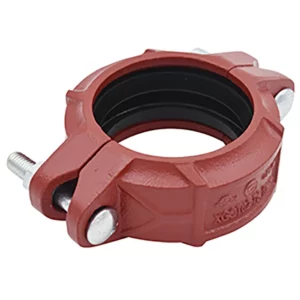Threadless rigid couplings are typically made from durable and corrosion-resistant materials to ensure the long-term integrity of piping connections.
Some common materials used in the manufacture of threadless rigid couplings include:
- Ductile Iron: Ductile iron is a popular material choice for rigid couplings due to its strength, corrosion resistance, and durability.
- Stainless Steel: Stainless steel is known for its excellent resistance to corrosion and is often used for couplings in environments where rust or chemical corrosion is a concern.
- Carbon Steel: Carbon steel couplings are robust and suitable for a wide range of applications. They are typically coated or painted to prevent rust.
- Copper: Copper couplings are used in plumbing and HVAC systems. Copper is known for its excellent heat and electrical conductivity.
- Brass: Brass is another material used in plumbing applications. It offers good corrosion resistance and is often chosen for potable water systems.
- Aluminum: Aluminum couplings are lightweight and suitable for specific applications where weight is a concern.
The choice of material depends on factors such as the type of piping, the operating environment, the medium being transported, and budget constraints. Different materials may be preferred for different applications to ensure the best performance and longevity of the coupling. Additionally, coatings and surface treatments may be applied to enhance the corrosion resistance of the couplings further.
What are some potential challenges or limitations associated with using threadless rigid couplings?
While threadless rigid couplings offer several advantages, they are not without challenges and limitations. Some potential issues and limitations associated with using threadless rigid couplings include:
- Limited Movement Tolerance: Threadless rigid couplings are designed to provide a secure and rigid connection. While this rigidity is an advantage in many applications, it can be a limitation when there is a need for some degree of movement or flexibility in the piping system. In such cases, flexible couplings or expansion joints may be more suitable.
- Higher Initial Cost: Threadless rigid couplings can be more expensive than some other types of couplings or connection methods. The initial cost can be a consideration for projects with tight budgets.
- Skilled Installation Required: Proper installation of threadless rigid couplings requires skilled personnel who can accurately measure and cut pipes and ensure precise alignment. If not installed correctly, leaks or misalignment can occur.
- Limited Size Range: Threadless rigid couplings may not be readily available in very small or very large sizes, limiting their use in extreme size ranges. In such cases, alternative coupling methods or connection techniques may be necessary.
- Temperature and Material Compatibility: Threadless rigid couplings may not be suitable for extreme temperature ranges, and the choice of materials should be compatible with the temperature and the type of material being transported. This can be a limitation in high-temperature or cryogenic applications.
- Vibration and Noise Transmission: The rigidity of threadless rigid couplings can transmit vibrations and noise throughout the piping system. threadless rigid coupling This can be a drawback in situations where noise reduction or vibration isolation is crucial.
- Maintenance and Repair Challenges: In cases where maintenance or repair is needed, removing and reinstalling threadless rigid couplings can be more complex than with some other coupling types. This can result in increased downtime and labor costs.
- Pressure Limitations: Threadless rigid couplings have pressure limitations, and in high-pressure applications, alternative coupling methods may be required.
It’s essential to carefully consider these limitations and challenges when choosing the appropriate coupling method for a specific piping system to ensure that it meets the requirements and constraints of the application.
